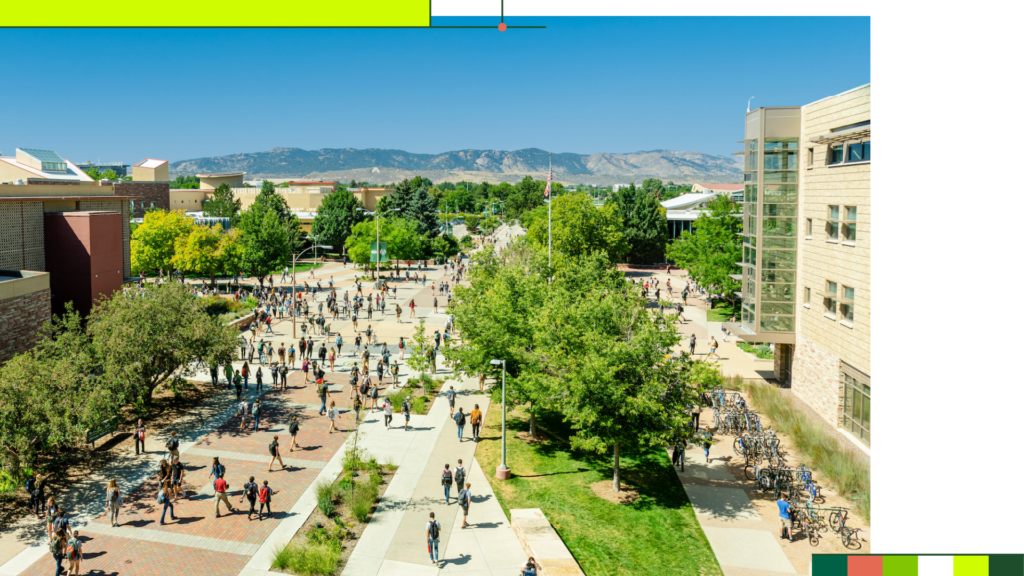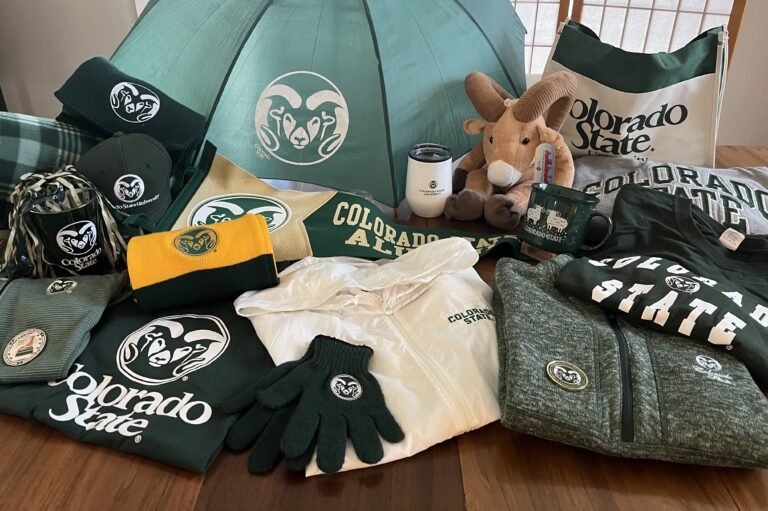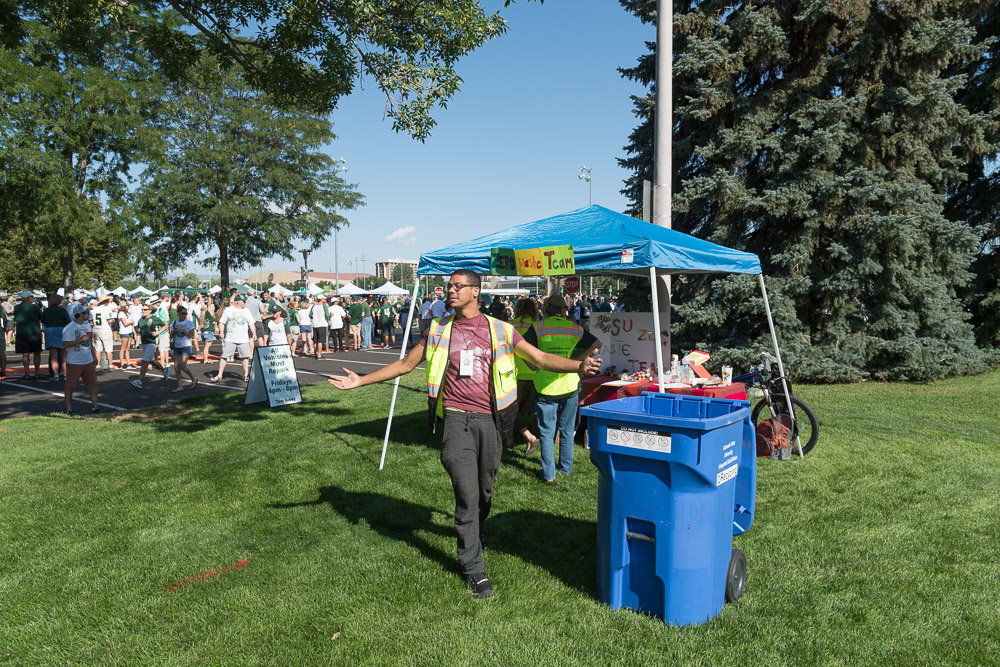
Campus
sustainability
guides
The Campus Sustainability Guides are resources, tips, and practices to help students, faculty, and CSU staff more sustainable.
sustainable
swag guide
Green
tailgating guide
Zero Waste
Event guide
sustainable
printing guide
Communicating
Climate guide
Platinum Guide
Book
Sustainable Engagement and Swag Guide
This guide is intended to be a resource for departments, student groups, and organizations within Colorado State University that are purchasing promotional materials (i.e. swag) to engage students, employees, alumni, or community members. CSU continues to work towards the goal of being an environmentally just, zero-waste campus. This means we must challenge ourselves to take into consideration the full life cycle of materials given away at events and programs, as well as the source of the materials. Often, inexpensive single-use plastic objects are selected because they are affordable and easy to find. But these items often end up in our landfill, or worse, in our environment or waterways.
If you are giving out promotional materials, please consider:
- An experience rather than an item (e.g. a repair station or how-to booth, photo booth, tickets to a show, gift card to a local restaurant or shop, or a behind-the scenes tour). Experiences can be a bigger draw to your table and studies show that experiences produce longer-lasting impact and memories than physical items.
- Upcycle/Reuse booth (e.g. decorate and plant existing flower pots, gear or clothing swaps, tie-dye old shirts, screen printing existing items like canvas shopping bags or towels).
- Durable and reusable items (e.g. water bottles, sewing or tool kits, cutlery, towels, socks, or pens that are refillable).
- Goods made from recycled, repurposed, compostable, or rapidly renewable materials (like 100% recycled plastic, bamboo, or compostable items).
- Goods that are Fair Trade Certified or from B Corporations (these certifications demonstrate a commitment to social and environmental responsibility).
- Energy-conserving or sustainable items (e.g. LED lights, safety accessories for bikes, seeds or plants, or consumable items like food).
If providing food (including packaged foods), consider choosing:
- Fair Trade, USDA Organic, or other third-party
sustainability certifications. - Locally grown/produced foods and products.
- Vegan or vegetarian options as they tend to have a lower carbon and nitrogen footprint.
Some questions to consider:
- Where the materials were made and by whom. How far will they need to travel? Was child labor used to produce these materials? What kind of packaging does the item come in?
- The purpose of the material. Will it promote health (both physical and mental health)? Will it promote thoughtful consumption? Is the item useful or likely to end up at the back of a drawer or in the trash?
- What is the purpose of your event/program? What do attendees find valuable? Lots of people pick up items because they are free but they may not find them valuable and freebies often have no connection to the bigger purpose of the event. Are attendees hoping to learn a specific skill? Are they hoping to connect or network with other attendees? Would a few bigger prizes be more valuable to attendees than lots of freebies?

Some questions to consider:
- For general recommendations visit the PLAN (Post-Landfill Action Network) Hierarchical Ethical Guide to Swag
- If you’d like to put the CSU logo on your items, visit https://licensing.colostate.edu to see a list of CSU licensed vendors. If you have found a sustainable item from a licensed vendor and need brand approval or you have identified a unique item from a non-licensed vendor and need to request an exemption, contact brand@colostate.edu for next steps.
- SOURCE Article on sustainable swag
Green tailgating guide
This guide is intended to be a resource for anyone planning to tailgate on a CSU Football Game Day or at any other CSU hosted or sponsored event. CSU is well known for its commitment to sustainability best practices – both in the classroom and throughout university operations. Ram fans can support these efforts in all the ways you plan for and participate in the tailgating experience. You can help CSU to embody and achieve its sustainability goals – as a fan, a guest, a partner – YOU are on the TEAM! Your thoughtful planning keeps Game Day fun and green.
Before we get into our sustainability-focused considerations – please take a moment to review the Colorado State University Tailgating and Game Day Activities Policy & Rules.
To incorporate sustainability best practices for tailgating at a CSU event, please consider:
- Plan your menu ahead to reduce over-buying, reducing general waste and food waste
- Food & drink: When you hit the store to purchase your tailgating foods, snacks, and drinks:
- Buy in bulk whenever you can to reduce the amount of packaging
- Avoid single serve or individually packaged items
- Purchase local / organic fruits and veggies. Buy Colorado Proud
- In fact, buy locally produced products as much as possible
- Lighten your food-related environmental impact. Consider non-red meat options. Or, best of all, create and enjoy a meat-free tailgate extravaganza!
- Buy in bulk whenever you can to reduce the amount of packaging

Reusables:
- Prep your tailgating foods, snacks, and drinks at home before coming to campus
- Transport and serve in re-usable bowls, trays, and jugs
- Stock your tailgating ‘box’ with re-usable and unbreakable plates and cups
- Use re-usable service ware (forks /
knives / spoons) - And, just like camping – consider ‘pack-it-in, pack-it-out’ and leave no trace!
Decorations:
- Please, do not bring or use paper streamers, balloons, confetti/glitter – they are likely to just blow away and become litter
- Check out the CSU Bookstore or our CSU Rams Official Team Store for the CSU Rams flag or banner you’ve always wanted
- Be classy – bring cloth napkins and table covers. Then, after each event you can take them home, wash them, and use them again and again
Do you have questions or suggestions?
Contact Stacey Baumgarn, CSU Campus Energy Coordinator: Stacey.Baumgarn@colostate.edu
Waste:
- Wish-cycling is a practice we want to avoid. Just because we want something to be recyclable, doesn’t mean it can be recycled. Help us keep our recycling ‘stream’ clean. Please, no wish-cycling
- When in doubt – throw it out!
- No liquids or food waste in the recycle, please. Only recycle containers that are empty
- Need an on-campus recycling refresher? Here is our Waste Sorting Guide
- If you’re a real champion – and have items that could be composted – we hope you’ll practice that camping type trick listed above – ‘pack it out,’ take it home and add it to your compost pile at home. Be green, go green and grow green!
Zero Waste Event Guide
This guide is intended to be a resource to departments, employees, student groups, and organizations within Colorado State University who are looking to host Zero Waste meetings or events.
Tips to host a zero-waste event:
- Go paperless and use web, social media, and email to promote the event as well as an online registration system rather than paper invites, posters, or RSVPs.
- If you must use paper for marketing materials, such as promotional posters or handouts, choose paper that is made from at least 30% recycled content, is recyclable, and/or is Forest Stewardship Certified. (see the Printing & Publications Sustainability Recommendations)
- Provide compostable serving ware (sorting will be cleaner if you go with all compostable; the more variation in materials, the harder it is to sort correctly). Contamination of the recycle and/or compost streams is to be avoided at all costs!” When streams of materials get contaminated – the result is a more expensive trip to the landfill for those materials. When in doubt – throw it out!
- Actively promote the zero waste aspects of your event and remind attendees to reduce waste by only bringing recyclable, reusable, and/or compostable materials with them to the event.
To host a zero-waste event:
- Provide composting and recycling receptacles in addition to landfill (trash) bins. Sorting will be most accurate if you have staff or volunteers at each waste station to help attendees sort properly. If you can’t staff the waste sorting station, have signage displayed over each receptacle to help facilitate proper sorting of materials (visual references are very helpful so consider taping the specific items that are available at your event above each receptacle as examples!).
- Serve drinks with a pitcher or self-serving container with reusable or compostable cups rather than single-use water bottles or cans – otherwise, be sure these items are empty of liquids and recycled (and skip plastic straws as they often end up in waterways where they are harmful to aquatic species).
- Choose reusable decorations (i.e., table clothes, centerpieces, or banners), rather than single-use plastic decorations.
- Reduce the amount of food waste by having attendees RSVP so you can give the caterer a more accurate head count. Work with your caterer to develop a plan for leftovers (donate to a local shelter, have participants take home leftovers, make them available to the venue staff, or compost).
- If the event is catered, actively work with the caterer to provide compostable serving materials, and ensure single-serve packets of condiments or individual packets are not provided but rather served in bulk. For example, have chips available in a large serving bowl instead of individual chip bags.
Sustainable Printing Guide
This guide is intended to be a resource to departments, student groups, and organizations within Colorado State University who print flyers, posters, brochures, magazines, or other publications and want to print sustainably. Colorado State University is continually striving to move the University towards a zero-waste campus. One important pathway is to challenge ourselves to take into consideration the full life cycle of publications produced. Here are a few tips for how you can help.
Sustainability Tips for Production:
- Ask – does this need to be printed or is an online or digital delivery channel better?
- Review and edit draft documents on-screen rather than printing paper copies.
- Create standard-sized publications or print multiple copies on one sheet (a 6 x 6 in. publication may be unique but can waste paper and raise costs of the project).
- Approach color creatively, can you make a two or three-color design as effective as a full color publication?
- Design your publication with margins instead of full bleed. “Full bleed” is a printing term that means that the document is printed larger than the finished product and then cut to the desired size. This is so the color goes to the absolute edge of the paper. This is done because printers cannot print to the edges of paper. Designing your publication without a full bleed increases the quantity of prints per full sheet of paper and reduces the amount of paper that is cut off and wasted.
- If you are mailing publications, print addresses directly on the envelopes to eliminate the use of non-recyclable address stickers. Also, keep your mailing list up to date to prevent waste and allow subscribers to opt in for digital delivery rather than print delivery.
- Make sure you have an option for subscribers to choose online / email delivery instead of a printed hard copy.
- When working with Creative Services, Fast Print, or an outside vendor ask them on what sustainable options or services they offer.
Sustainability Tips for Printing:
- Purchase office paper with post-consumer recycled, agricultural residue, and/or Forest Stewardship Council (FSC) certified content. (There are lots of great papers containing 90-100% of these contents on the market today. It can be cost-effective to target 50% content at a minimum).
- When you choose these criteria, you help the institution contribute to the conservation of water, energy, and virgin forest.
- Use 100% PCF (Processed Chlorine Free) paper.
- As a last resort, Use Forest Stewardship Council (FSC) certified paper.
- What ink options are available? You may be able to use or request soy or vegetable-based inks, or a variety of other non-toxic inks on the market.
- Is the printing company Green e-Certified or using renewable energy to power their facility?
- Print digitally instead of offset whenever possible. This decreases the amount of paper overage and energy costs associated with offset printing.
- Do not print on bright neon colored paper. This paper is not recyclable.
- Print only the amount you need and consider digital printing to make future runs easier and cheaper.
- Print double-sided whenever possible and try working with your department to set the default to print double-sided.
- Make sure your documents do not have an extra linefeed character at the end that forces a new blank page at the end of documents printed from other operating systems.

If you are printing in the office:
- Sustainability best practice: consider getting rid of your personal desk-top printer.
- The cost and impact per page are always less when using a shared multi-function central printer.
- Ditching your desktop printer helps CSU save $ and resources – on paper, ink, electricity, and equipment replacement
- Learn more about Ditching Desktop Printers
Finally, close the loop and ensure your publications are 100% recyclable:
- Find out if your printed product can be recycled after use. Some coatings that make paper smooth or shiny can make your printed product non-recyclable.
- Use non-toxic glues. These are available for most binding techniques, eliminating the need for ventilation of toxic fumes and waste management issues.
Spread the word and show that your publication is sustainable by using one or more of the following tags:
“This publication was printed on
post-consumer recycled paper.”
“This publication was printed with
plant-based inks.”
“This publication is printed on
100% recycled paper.”
“This publication was made with
FSC-certified paper”
“When you are finished, please pass along or recycle this publication.”
Thanks for your consideration and efforts to print and publish with sustainability in mind. Please share your examples with our committee – send examples to: Kirstie.Tedrick@colostate.edu. And, if you have questions or suggestions to improve this list, please email: Kirstie.Tedrick@colostate.edu.
Communicating Climate Guide
This guide provides strategies and support for engaging in the climate change conversation. This guide was created by the Sustainable Living Association. Click here to view the Communicating Climate Guide (PDF).
Platinum Guide Book
This guide provides the CSU community with learning opportunities and strategies for living and learning sustainability, and how they can positively contribute to the actions being taken at a University level and beyond. Click here to view the Platinum Guide Book (PDF).